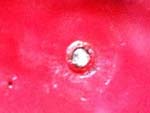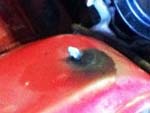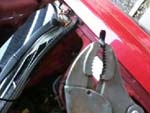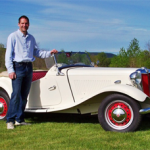To start off with, I wanted to thank you for letting me adorn the front cover of Wheel Tracks with a couple of cars that may seem a bit out of character for such a publication. I say this because when you crack the door open on most feature article cars, the new car smell has pretty much worn off. But at the ripe young age of only 20, these babies are still wet behind the ears. Enter, the 1991 Buick Reatta coupe. I would also like to introduce my daughter Jessica (she has taken a special interest in the Polo green) and my son Jason (he’s got dibs on the Maui blue).
My first sighting of a Reatta seemed almost magical. It was in the spring of 1988 and I was stopped at a busy intersection. From my left came a white streak that as it passed in front of me, seemed to be moving in slow motion (you know the feeling). As the car traveled over the crest of the road, the chassis sprung up and the car appeared to be airborne. As it darted away, I was trying to guess what I had just seen. I didn’t know what it was, but I knew I liked it. I would later find out it was an American made luxury two seat sport coupe that was hand built at the Craft Center in Lansing Michigan. With a price tag way out of my reach, It became a forgotten memory. As the years passed, I would make random sightings of this rare and elusive automobile.
Fast forward to the year 2000. On an annual trip back home (Maine), traveling early in the morning on Rt15 east out of Morrisville, we passed Morrisville Used Auto. As I took a casual glance at the car lot, my foot suddenly came off the accelerator (here goes that slow motion thing again). I looked at my wife and without either of us saying anything; she rolled her eyes to the left. This is good because that means “go ahead, you can turn around”. When they roll to the right, it means “you’re crazy, keep driving”. After turning around, we found a shiny 1991Maui blue Reatta in a long line of fine automobiles. Later the next week the car would be in my driveway. I have learned that this particular Reatta had only one twin in 1991. No wonder it was so hard to find.
I picked up the Polo green car in 2010. Its main intention was for parts, but I couldn’t resist, and completed the necessary repairs to get it on the road. July of this year, our family took both cars to the Buick Club of America’s national car meet in Danvers, MA. We had a great time touring the local area, seeing the Red Sox play, and listening to the Boston Pops during the 4th of July fireworks. While at the BCA show, both kids earned their Jr. judging credentials. Jessica helped with the 1940’s class and Jason kept the senior judges hopping in the Reatta class.
Our family has gotten a lot of enjoyment out of the two cars, but the friends we have found in the VAE family and the Buick circle, have been the biggest reward. We look forward to many more stories and adventures within the VAE as our two Buicks motor on.
Fun facts: Years of production 1988 thru spring of 1991. Total number of cars produced 21,751. First 2 prototypes were built in England. Hand built at craft stations, no assembly line used. Cars were sold in house to the PPG paint group, body and paint completed and then sold back to Cadillac. Cadillac owned the Craft Center. Once the cars were completed, Cadillac sold the cars to Buick. 60% of all parts are shared with the Buick Riviera.










 Here, the fastener is broken off, the metal has been cleaned up and is ready for the weld.
Here, the fastener is broken off, the metal has been cleaned up and is ready for the weld. Here, the metal bulb is welded to the end of the broken stud. While the weld is still hot, penetrating oil is sprayed on the broken stud.
Here, the metal bulb is welded to the end of the broken stud. While the weld is still hot, penetrating oil is sprayed on the broken stud. After locking on the bulb with vise grips, the broken stud was coaxed out by gently rocking it back and forth until it easily unscrewed. You can see the shiny steel weld in the jaws of the vise grips, and the rust colored threads of the broken stud.
After locking on the bulb with vise grips, the broken stud was coaxed out by gently rocking it back and forth until it easily unscrewed. You can see the shiny steel weld in the jaws of the vise grips, and the rust colored threads of the broken stud. Please email all inquiries to:
Please email all inquiries to: 
